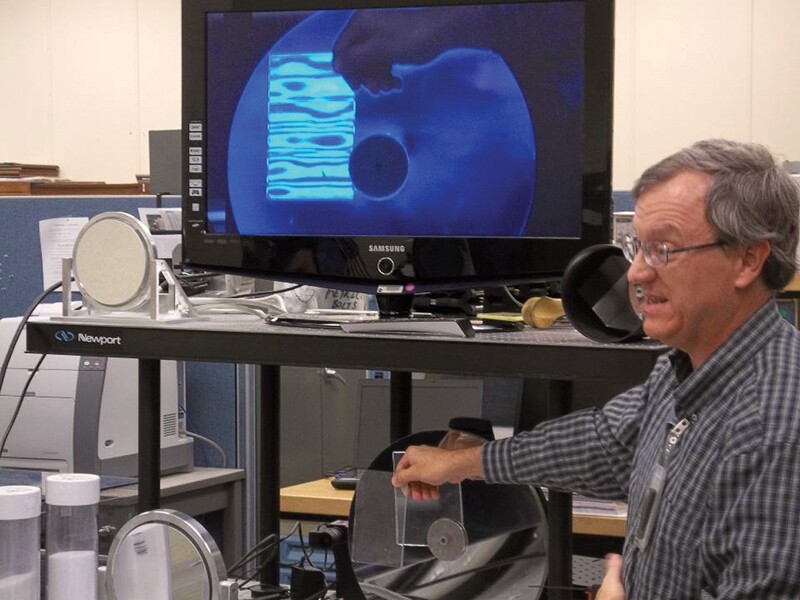NASA Takes Center Stage

NASA’s Bob Youngquist demonstrates a device for detecting leaks. Photo by Michael Harrington
For those of us who have dreamed of going into space ever since we were young children, the NASA John F. Kennedy Space Center (KSC) was the most exciting part of the 2012 Quadrennial Physics Conference. On the press bus during the KSC tours, we were treated to exclusive looks at three exciting labs.
At the Applied Physics lab, we were shown a camera capable of imaging air currents, an ultrasonic leak detector, and a vacuum cleaner designed to suck water out of shuttle tiles, among other pieces of equipment. We visited the LAVA lab, dedicated to the design of a mass spectrometer for the Canadian Space Agency’s lunar rover, and heard about difficulties in designing instrumentation capable performing the intended task and surviving the harsh realities of space. After the LAVA lab, we visited the Granular Materials and Regolith Operations lab, where Dr. Phil Metzger told us about his work developing an autonomous mining system and designing methods to build launch pads and roads out of lunar soil.
With the lab tours finished, we set off for launch complex 39A, where Apollo 11 set off for the moon those 43 years ago. This was followed by visits to the Vehicle Assembly Building, the mobile launch pads, the Crawlerway, and most exciting to us, the landing strip where the shuttle and shuttle carrier landed. As we turned the corner into the visitor’s center, there was the tail end of Atlantis peeking coyly out from its new home.
Later that evening we heard the first plenary talk, by Dr. John Grunsfeld, who never dreamed of being a physicist—until he was assigned to write a biography on Enrico Fermi—a project which piqued his interest in physics and forever changed his life. Grunsfeld has a PhD in high energy astrophysics and has been on five space shuttle flights. As physicists, one of the most important things we learn in classes is how to troubleshoot. However, when you are working on a sensitive space telescope orbiting the Earth with limited resources and time, troubleshooting is a little different. During the spacewalks in which he repaired the Hubble Space Telescope, Grunsfeld had to work with NASA to come up with new repair methods on the fly, while tethered to the space shuttle. Sometimes it is difficult to apply what we have learned to the real world, but Grunsfeld’s stories were able to help bridge that gap.
Many of us never thought we would be a part of PhysCon 2012. The vast size and diversity of the physics community that gathered for the meeting was surprising. Attending the conference was a wonderful experience that gave us many opportunities to develop and bond with each other, as well as develop ties to other chapters and physics professionals. As one scientist impressed upon us, “Make sure that you are always doing what you love. If you do what you love, the rest will fall into place.”
More Information
Take a virtual visit to Kennedy Space Center via Google Maps at: http://maps.google.com/intl/en/help/maps/streetview/gallery/nasa/



